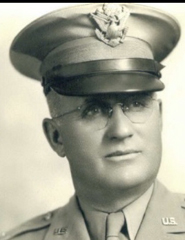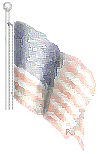Caribou Hero of Miles Story
By Frank Miles
With the 158th Regimental Combat Team in Luzon (IDPA) -- Malenas, solid, stolid, mud-crusted caribou, is the hero of this tale.
Brig. Gen. Hanford MacNider, of Mason City, in command of the 158th regimental combat team, his orderly and I were traveling by jeep on a mountain jungle trail. MacNider was driving. We came to a creek about three feet deep from which a bridge had been washed out by rain. MacNider thought we could ford and plowed into the water. In mid stream our wheel stuck in the soft bottom. About 40 natives waded out, grabbed our vehicle and at commands from the orderly pulled, pushed, tugged and shattered while MacNider stepped on the gas. After 15 minutes, we appeared to be hopelessly mired.
The came along Malenas with a native on his back. Gravely he obeyed order to maneuver himself in front of the machine. Then he laid down. Natives soaked his back with water. Then he arose. Collar was adjusted over his shoulders. Hemp rope was stretched from it to our front bumper.The orderly yelled. All the Filipinos but three pushed. The on-pushers smacked the caribou with flat sides of bolos. Malenas refused to move and so did the jeep.
Suddenly something must have exploded in the beasts brain. He lunged forward and out of the mud and water and up a steep bank we went so fast many of our brown helpers were dragged along. Seeing we were clear, the crowd of natives cheered like an American baseball crowd if a home-run had been hit with three on bases in a tight game.
Malenas looked at we Americans disdainfully as we drove away. That was one of the amusing incidents of my visit with the noted Iowan, who led his men in person in attacks on the Japs in south Luzon that finally ended in their being almost wholly killed or captured.
We saw a supply train operated by MacNider's men, which was called "The Riotous Rocket, the Careening Comet and the Slightly Spent Bullet."
MacNider showed me a duffel bag of his in which most of his clothes had been shot full of holes by a Japanese shell.
His men called him "Happy" because he smiled when he speaks to them and when he return their salute. They smile, too, when they see him. Since his old friends called him 'Jack" he probably will be "Happy Jack" when he returns home.
MacNider landed in Australia Jan. 14, 1942. After a tour he went to New Guinea where he was hit by 20 pieces of steel from a Japanese rifle grenade. One almost cost him an eye but he flew to New York where treatment cured the wound, then flew back to the scene of action.
About year ago, he was given his present command which he calls "the sweetest in the army." It is composed of 37 units and 10 attached units. Originally the infantry men were from the Arizona national guard but there have been many replacements. Insignia of the outfit is a bush master snake coiled around a bolo and soldiers are known as 'Bush Masters".
The Luzon fight was in three phases: Jan 11 to Feb 13, March 3 to March 20, and April 1 to June 30. The last was the toughest for it was fought around and atop nine mountains so jungled with trees, abacs, vines and underbrush that the attackers often could not see 10 feet ahead. The Japs, who had been in the area a long time, knew every foot of the terrain and were strongly entrenched.
When MacNider's men landed on Legaspi harbor beach after air bombing and navy shelling of enemy installations they encountered hundred of pill boxes, wide mine field and huge barricades of palm logs. They were subjected to murderous fire. After surmounting those obstacle they plunged through slippery, steaming jungles, muddy rice fields and climbed steep slopes under blazing sun and torrential downpours. They simply had to find the Japs and dig them out.
This they did with the loss of only one man killed to each 28 Japs dispatched. Many Iowans were in the battle.
Source: Mount Pleasant News, August 16, 1945
![]()

